Estimation of Groundwater Recharge in Kumamoto Area, Japan in 2016 by Mapping Land Cover Using GIS Data and SPOT 6/7 Satellite Images
Abstract
1. Introduction
2. Related Work
3. Materials and Methods
3.1. Satellite Image Data
3.2. Land Cover Map Creation
3.3. Accuracy Assessment
3.4. Calculation Method of Groundwater Recharge
3.4.1. Groundwater Recharge from Paddy Fields
3.4.2. Groundwater Recharge Other Than Paddy Fields
3.4.3. Evapotranspiration
4. Results
4.1. Effect of Kernel Filter Size
4.2. Classification Results
4.3. Land Cover
4.4. Groundwater Recharge
5. Discussion
6. Conclusions
Author Contributions
Funding
Institutional Review Board Statement
Informed Consent Statement
Conflicts of Interest
References
- Kumamoto Prefecture and Kumamoto City. Report on Comprehensive Survey on Groundwater in Kumamoto Area in 1994; Kumamoto Prefecture and Kumamoto City: Kumamoto, Japan, 1995. [Google Scholar]
- Ide, K.; Suzuki, H.; Koga, H.; Shimada, J. Compensation method of groundwater level corresponding to the wellhead elevation change after the Kumamoto Earthquake. J. Groundw. Hydrol. 2019, 61, 197–203. [Google Scholar] [CrossRef]
- Imatsuji, G.; Ichikawa, T.; Aramaki, S. On the spring rate change and those mechanizm in the Ezu Lake and Suizenji, Kumamoto. Bull. Sch. Ind. Eng. Tokai Univ. 2008, 1, 46–52. [Google Scholar]
- Ichikawa, T.; Nakagawa, K.; Berndtsson, R. Earthquake effects on artificial groundwater recharge efforts in south Japan. Environ. Earth Sci. 2020, 79, 142. [Google Scholar] [CrossRef]
- Comprehensive Conservation and Management Plan for Groundwater in Kumamoto Area. Available online: https://www.pref.kumamoto.jp/uploaded/attachment/51663.pdf (accessed on 16 February 2021).
- Shimada, J. Recent challenges for sustainable groundwater management at Kumamoto Area, based on the regional groundwater flow system -Pumping permission for the regional groundwater management. J. Groundw. Hydrol. 2013, 55, 157–164. [Google Scholar] [CrossRef]
- Ozasa, Y. Regional characteristics of groundwater quality in Kumamoto Prefecture—A visualization study using grid maps. J. Environ. Lab. Assoc. 2005, 30, 239–245. [Google Scholar]
- Tomiie, K.; Itomitsu, N.; Matsuyama, K.; Kakimoto, R.; Kawagoshi, Y. Nitrate-nitrogen concentration in groundwater of Kumamoto urban area and determination of its contributors using geographical information system and nitrogen stable isotope analysis. J. Jpn. Soc. Water Environ. 2011, 34, 1–9. [Google Scholar] [CrossRef][Green Version]
- Hosono, T.; Tokunaga, T.; Kagabu, M.; Nakata, H.; Orishikida, T.; Lin, I.-T.; Shimada, J. The use of δ15N and δ18O tracers with an understanding of groundwater flow dynamics for evaluating the origins and attenuation mechanisms of nitrate pollution. Water Res. 2013, 47, 2661–2675. [Google Scholar] [CrossRef]
- Hirohata, M.; Ozasa, Y.; Matsuzaki, T.; Fujita, I.; Matsuoka, R.; Watanabe, S. The mechanism of groundwater pollution by nitrate-nitrogen at U-town in Kumamoto Prefecture. J. Groundw. Hydrol. 1999, 41, 291–306. [Google Scholar] [CrossRef][Green Version]
- Hosono, T.; Yamada, C.; Shibata, T.; Tawara, Y.; Wang, C.-Y.; Manga, M.; Rahman, A.T.M.S.; Shimada, J. Coseismic groundwater drawdown along crustal ruptures during the 2016 Mw 7.0 Kumamoto Earthquake. Water Resour. Res. 2019, 55, 5891–5903. [Google Scholar] [CrossRef]
- Hosono, T.; Yamada, C.; Manga, M.; Wang, C.-Y.; Tanimizu, M. Stable isotopes show that earthquakes enhance permeability and release water from mountains. Nat. Commun. 2020, 11, 2776. [Google Scholar] [CrossRef] [PubMed]
- Kagabu, M.; Ide, K.; Hosono, T.; Nakagawa, K.; Shimada, J. Describing coseismic groundwater level rise using tank model in volcanic aquifers, Kumamoto, southern Japan. J. Hydrol. 2020, 582, 124464. [Google Scholar] [CrossRef]
- Ide, K.; Hosono, T.; Kagabu, M.; Fukamizu, K.; Tokunaga, T.; Shimada, J. Changes of groundwater flow systems after the 2016 Mw 7.0 Kumamoto earthquake deduced by stable isotopic and CFC-12 compositions of natural springs. J. Hydrol. 2020, 583, 124551. [Google Scholar] [CrossRef]
- Miyakoshi, A.; Taniguchi, M.; Ide, K.; Kagabu, M.; Hosono, T.; Shimada, J. Identification of changes in subsurface temperature and groundwater flow after the 2016 Kumamoto earthquake using long-term well temperature–depth profiles. J. Hydrol. 2020, 582, 124530. [Google Scholar] [CrossRef]
- Tawara, Y.; Hosono, T.; Fukuoka, Y.; Yoshida, T.; Shimada, J. Quantitative assessment of the changes in regional water flow systems caused by the 2016 Kumamoto Earthquake using numerical modeling. J. Hydrol. 2020, 583, 124559. [Google Scholar] [CrossRef]
- Nakagawa, K.; Yu, Z.-Q.; Berndtsson, R.; Hosono, T. Temporal characteristics of groundwater chemistry affected by the 2016 Kumamoto earthquake using self-organizing maps. J. Hydrol. 2020, 582, 124519. [Google Scholar] [CrossRef]
- Nakagawa, K.; Shimada, J.; Yu, Z.-Q.; Ide, K.; Berndtsson, R. Effects of the Japanese 2016 Kumamoto earthquake on nitrate content in groundwater supply. Minerals 2021, 11, 43. [Google Scholar] [CrossRef]
- Ishii, E.; Watanabe, Y.; Agusa, T.; Hosono, T.; Nakata, H. Acesulfame as a suitable sewer tracer on groundwater pollution: A case study before and after the 2016 Mw 7.0 Kumamoto earthquakes. Sci. Total Environ. 2021, 754, 142409. [Google Scholar] [CrossRef]
- Kanamori, N. Damage to agriculture caused by the 2016 Kumamoto earthquake and the efforts of extension organizations. Rep. Kyushu Branch Crop Sci. Jpn. 2017, 83, 57–60. [Google Scholar]
- The 2016 Kumamoto Earthquake—Landslide Distribution Map Seen from the Sky (by Aerial Photo Reading) in Aso and Kumamoto Area. Available online: https://www.gsi.go.jp/common/000143459.pdf (accessed on 2 March 2021).
- Third Action Plan Based on the Comprehensive Conservation and Management Plan for Groundwater in Kumamoto Area. Available online: https://www.pref.kumamoto.jp/soshiki/49/5554.html (accessed on 15 October 2021).
- Fauzia; Surinaidu, L.; Rahman, A.; Ahmed, S. Distributed groundwater recharge potentials assessment based on GIS model and its dynamics in the crystalline rocks of South India. Sci. Rep. 2021, 11, 11772. [Google Scholar] [CrossRef]
- Ahirwar, S.; Malik, M.S.; Ahirwar, R.; Shukla, J.P. Identification of suitable sites and structures for artificial groundwater recharge for sustainable groundwater resource development and management. Groundw. Sustain. Dev. 2020, 11, 100388. [Google Scholar] [CrossRef]
- Batarseh, M.; Imreizeeq, E.; Tilev, S.; Al Alaween, M.; Suleiman, W.; Al Remeithi, A.M.; Al Tamimi, M.K.; Al Alawneh, M. Assessment of groundwater quality for irrigation in the arid regions using irrigation water quality index (IWQI) and GIS-Zoning maps: Case study from Abu Dhabi Emirate, UAE. Groundw. Sustain. Dev. 2021, 14, 100611. [Google Scholar] [CrossRef]
- Calculation Method of Estimated Recharge Due to Groundwater Recharge Measures in Priority Areas (Kumamoto Area). Available online: https://www.pref.kumamoto.jp/uploaded/attachment/51876.pdf (accessed on 16 February 2021).
- Liu, W.; Yamazaki, F.; Maruyama, Y. Detection of earthquake-induced landslides during the 2018 Kumamoto earthquake using multitemporal airborne lidar data. Remote Sens. 2019, 11, 2292. [Google Scholar] [CrossRef]
- Gautam, N.C.; Chennaiah, G.C. Land-use and land-cover mapping and change detection in Tripura using satellite LANDSAT Data. Int. J. Remote Sens. 1985, 6, 517–528. [Google Scholar] [CrossRef]
- Tin-Seong, K. Integrating GIS and remote sensing techniques for urban land-cover and land-use analysis. Geocarto Int. 1995, 10, 39–49. [Google Scholar] [CrossRef]
- Yang, X.; Lo, C.P. Using a time series of satellite imagery to detect land use and land cover changes in the Atlanta, Georgia metropolitan area. Int. J. Remote Sens. 2002, 23, 1775–1798. [Google Scholar] [CrossRef]
- Chen, Y.; Shi, P.; Fung, T.; Wang, J.; Li, X. Object-oriented classification for urban land cover mapping with ASTER imagery. Int. J. Remote Sens. 2007, 28, 4645–4651. [Google Scholar] [CrossRef]
- Leinenkugel, P.; Kuenzer, C.; Oppelt, N.; Dech, S. Characterisation of land surface phenology and land cover based on moderate resolution satellite data in cloud prone areas—A novel product for the Mekong Basin. Remote Sen. Environ. 2013, 136, 180–198. [Google Scholar] [CrossRef]
- Vittek, M.; Brink, A.; Donnay, F.; Simonetti, D.; Desclée, B. Land cover change monitoring using landsat MSS/TM satellite image data over west Africa between 1975 and 1990. Remote Sens. 2014, 6, 658–676. [Google Scholar] [CrossRef]
- Jia, K.; Liang, S.; Wei, X.; Yao, Y.; Su, Y.; Jiang, B.; Wang, X. Land cover classification of landsat data with phenological features extracted from time series MODIS NDVI data. Remote Sens. 2014, 6, 11518–11532. [Google Scholar] [CrossRef]
- Soffianian, A.; Madanian, M. Monitoring land cover changes in Isfahan Province, Iran using Landsat satellite data. Environ. Monit. Assess. 2015, 187, 543. [Google Scholar] [CrossRef]
- Marie Mireille, N.; MMwangi, H.M.; Mwangi, J.K.; Mwangi Gathenya, J. Analysis of land use change and its impact on the hydrology of Kakia and Esamburmbur sub-watersheds of Narok county, Kenya. Hydrology 2019, 6, 86. [Google Scholar] [CrossRef]
- Matlhodi, B.; Kenabatho, P.K.; Parida, B.P.; Maphanyane, J.G. Evaluating land use and land cover change in the Gaborone dam catchment, Botswana, from 1984–2015 using GIS and remote sensing. Sustainability 2019, 11, 5174. [Google Scholar] [CrossRef]
- Mawenda, J.; Watanabe, T.; Avtar, R. An analysis of urban land use/land cover changes in Blantyre City, Southern Malawi (1994–2018). Sustainability 2020, 12, 2377. [Google Scholar] [CrossRef]
- Duan, C.; Shi, P.; Song, M.; Zhang, X.; Zong, N.; Zhou, C. Land use and land cover change in the Kailash Sacred Landscape of China. Sustainability 2019, 11, 1788. [Google Scholar] [CrossRef]
- Ojeda Olivares, E.A.; Sandoval Torres, S.; Belmonte Jiménez, S.I.; Campos Enríquez, J.O.; Zignol, F.; Reygadas, Y.; Tiefenbacher, J.P. Climate change, land use/land cover change, and population growth as drivers of groundwater depletion in the Central Valleys, Oaxaca, Mexico. Remote Sens. 2019, 11, 1290. [Google Scholar] [CrossRef]
- Nath, B.; Niu, Z.; Singh, R.P. Land Use and Land Cover changes, and environment and risk evaluation of Dujiangyan city (SW China) using remote sensing and GIS techniques. Sustainability 2018, 10, 4631. [Google Scholar] [CrossRef]
- Guerrero-Morales, J.; Fonseca, C.R.; Goméz-Albores, M.A.; Sampedro-Rosas, M.L.; Silva-Gómez, S.E. Proportional variation of potential groundwater recharge as a result of climate change and land-use: A study case in Mexico. Land 2020, 9, 364. [Google Scholar] [CrossRef]
- Mugo, R.; Waswa, R.; Nyaga, J.W.; Ndubi, A.; Adams, E.C.; Flores-Anderson, A.I. Quantifying land use land cover changes in the Lake Victoria basin using satellite remote sensing: The trends and drivers between 1985 and 2014. Remote Sens. 2020, 12, 2829. [Google Scholar] [CrossRef]
- Zhang, F.; Tiyip, T.; Feng, Z.D.; Kung, H.-T.; Johnson, V.C.; Ding, J.L.; Tashpolat, N.; Sawut, M.; Gui, D.W. Spatio-temporal patterns of land use/cover changes over the past 20 years in the middle reaches of the Tarim river, Xinjiang, China. Land Degrad. Dev. 2015, 26, 284–299. [Google Scholar] [CrossRef]
- Bakr, N.; Afifi, A.A. Quantifying land use/land cover change and its potential impact on rice production in the Northern Nile Delta, Egypt. Remote Sens. Appl. Soc. Environ. 2019, 13, 348–360. [Google Scholar] [CrossRef]
- Amano, H.; Iwasaki, Y. Land cover classification by integrating NDVI time series and GIS data to evaluate water circulation in Aso caldera, Japan. Int. J. Environ. Res. Public Health 2020, 17, 6605. [Google Scholar] [CrossRef]
- Stuckens, J.; Coppin, P.R.; Bauer, M.E. Integrating contextual information with per-pixel classification for improved land cover classification. Remote Sens. Environ. 2000, 71, 282–296. [Google Scholar] [CrossRef]
- Kagabu, M.; Matsunaga, M.; Ide, K.; Momoshima, N.; Shimada, J. Groundwater age determination using 85Kr and multiple age tracers (SF6, CFCs, and 3H) to elucidate regional groundwater flow systems. J. Hydrol. Reg. Stud. 2017, 12, 165–180. [Google Scholar] [CrossRef]
- Kumahara, Y.; Okada, S.; Inohara, K.; Kaneda, H.; Gotou, H.; Tsutsumi, H. 1:25,000 Active Fault Map Kumamoto; Revised Edition; Geospatial Information Authority of Japan: Ibaraki, Japan, 2017. [Google Scholar]
- Suzuki, Y.; Ishimura, D.; Kumaki, Y.; Kumahara, Y.; Chida, N.; Nakata, T.; Nakano, T. 1:25,000 Active Fault Map Aso; Geospatial Information Authority of Japan: Ibaraki, Japan, 2017. [Google Scholar]
- Gotou, H.; Inohara, K.; Kumahara, Y.; Koyama, T.; Chida, N.; Nakata, T. 1:25,000 Active Fault Map Yatsushiro; Revised Edition; Geospatial Information Authority of Japan: Ibaraki, Japan, 2018. [Google Scholar]
- Agriculture Land Information System. Available online: https://www.alis-ac.jp/ (accessed on 26 July 2021).
- Fundamental Geosapatial Data Download Service. Available online: https://fgd.gsi.go.jp/download/menu.php (accessed on 27 April 2021).
- The Results of the National Surveys on the Natural Environment. Available online: http://gis.biodic.go.jp/webgis/sc-023.html (accessed on 28 January 2020).
- Furukawa, F.; Morimoto, J.; Yoshimura, N.; Kaneko, M. Comparison of Conventional Change Detection Methodologies Using High-Resolution Imagery to Find Forest Damage Caused by Typhoons. Remote Sens. 2020, 12, 3242. [Google Scholar] [CrossRef]
- Yamazaki, F.; Liu, W. Remote sensing technologies for post-earthquake damage assessment: A case study on the 2016 Kumamoto earthquake. In Proceedings of the 6th ASIA Conference on Earthquake Engineering, Cebu City, Philippines, 22–24 September 2016. [Google Scholar]
- L3 Harris Geospatial Documentation Center. Available online: https://www.l3harrisgeospatial.com/docs/classification.html (accessed on 26 July 2021).
- Sueyoshi, E.; Tsudome, Y.; Baba, M. Survey of land use in the Kumamoto area using satellite images. Annu. Rep. Kumamoto City Environ. Res. Inst. 2005, 60–66. [Google Scholar]
- Map and Aerial Photo Viewing Service. Available online: https://mapps.gsi.go.jp/maplibSearch.do#1 (accessed on 13 July 2021).
- Ichikawa, T. Report on the Evaluation of Recharge Capacity by Paddy Fields in Kumamoto Plain and Aso Caldera; Tokai University: Kumamoto, Japan, 2021; 105p. [Google Scholar]
- Past Weather Data. Available online: https://www.data.jma.go.jp/obd/stats/etrn/index.php?prec_no=86&block_no=47819 &year =& month=&day=&view= (accessed on 16 February 2021).
- Lu, J.; Sun, G.; McNulty, S.G.; Amatya, D.M. A comparison of six potential evapotranspiration methods for regional use in the southeastern United States. J. Am. Water Resour. Assoc. 2005, 41, 621–633. [Google Scholar] [CrossRef]
- Zhang, F.; Kung, H.-T.; Johnson, V.C. Assessment of land-cover/land-use change and landscape patterns in the two national nature reserves of Ebinur Lake Watershed, Xinjiang, China. Sustainability 2017, 9, 724. [Google Scholar] [CrossRef]
- High-Resolution Land Use and Land Cover Map of Japan (Released in March 2018/Version 18.03). Available online: https://www.eorc.jaxa.jp/ALOS/en/lulc/lulc_index.htm (accessed on 2 August 2021).
- FY2021 Vision for Strengthening Profitability of Paddy Fields in Kumamoto Prefecture. Available online: https://www.pref.kumamoto.jp/soshiki/76/102900.html (accessed on 11 October 2021).
- Matsumoto, M.; Shimokawa, E.; Jitousono, T. A natural revegetation process on shallow landslide scars. J. Jpn. For. Soc. 1999, 81, 65–73. [Google Scholar]
- Conservation Measures Guideline for Groundwater in Kumamoto City. Available online: https://www.city.kumamoto.jp/kankyo/common/UploadFileDsp.aspx?c_id=5&id=20309&set_doc=1&set_file_field=1 (accessed on 16 February 2021).
- Maruyama, A.; Ikawa, H. Impacts of the 2016 Kumamoto earthquake on water-table reduction rate in paddy fields. Mem. Natl. Agric. Rec. Cent. Kyushu Okinawa Reg. 2019, 95, 10–17. [Google Scholar]
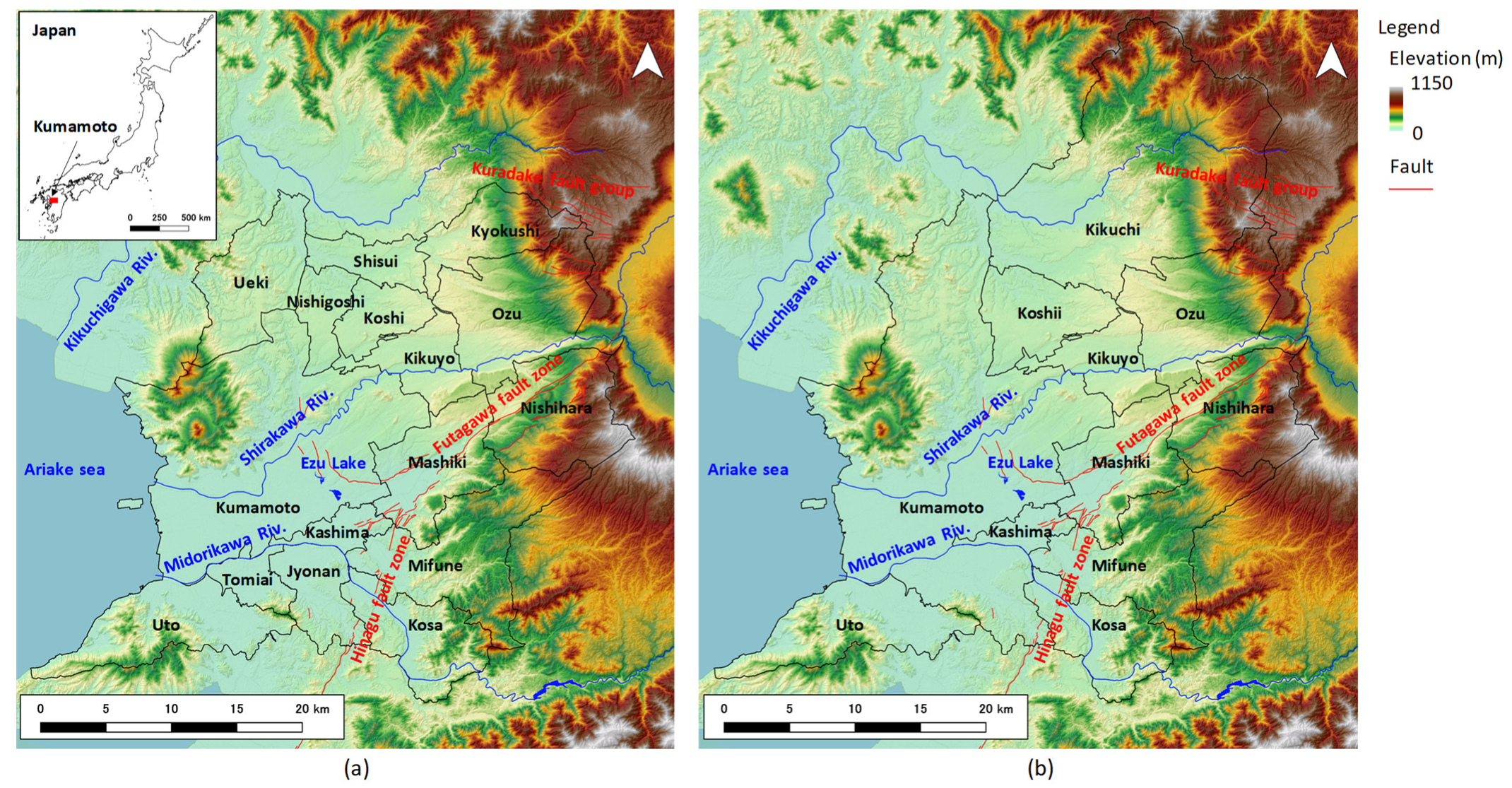
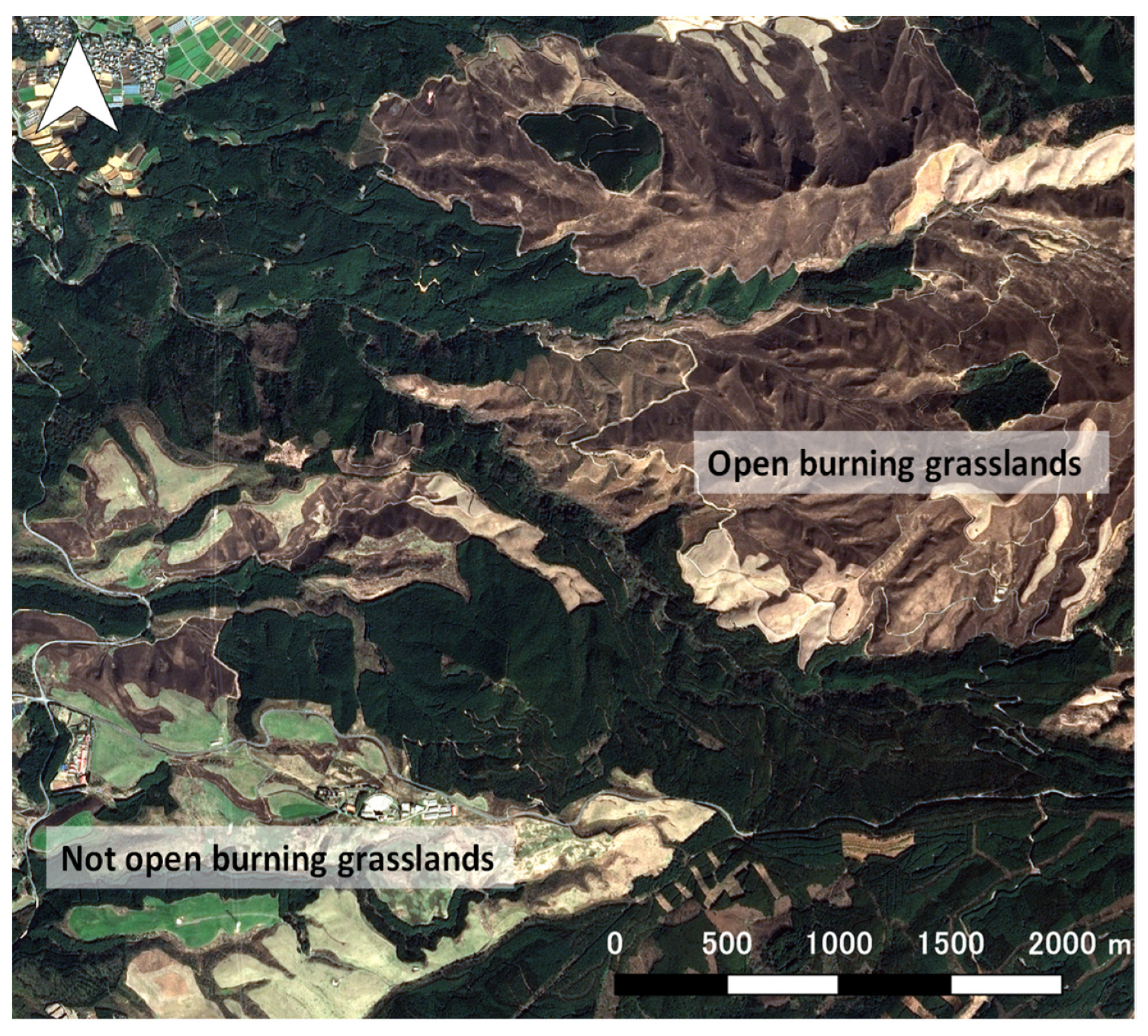
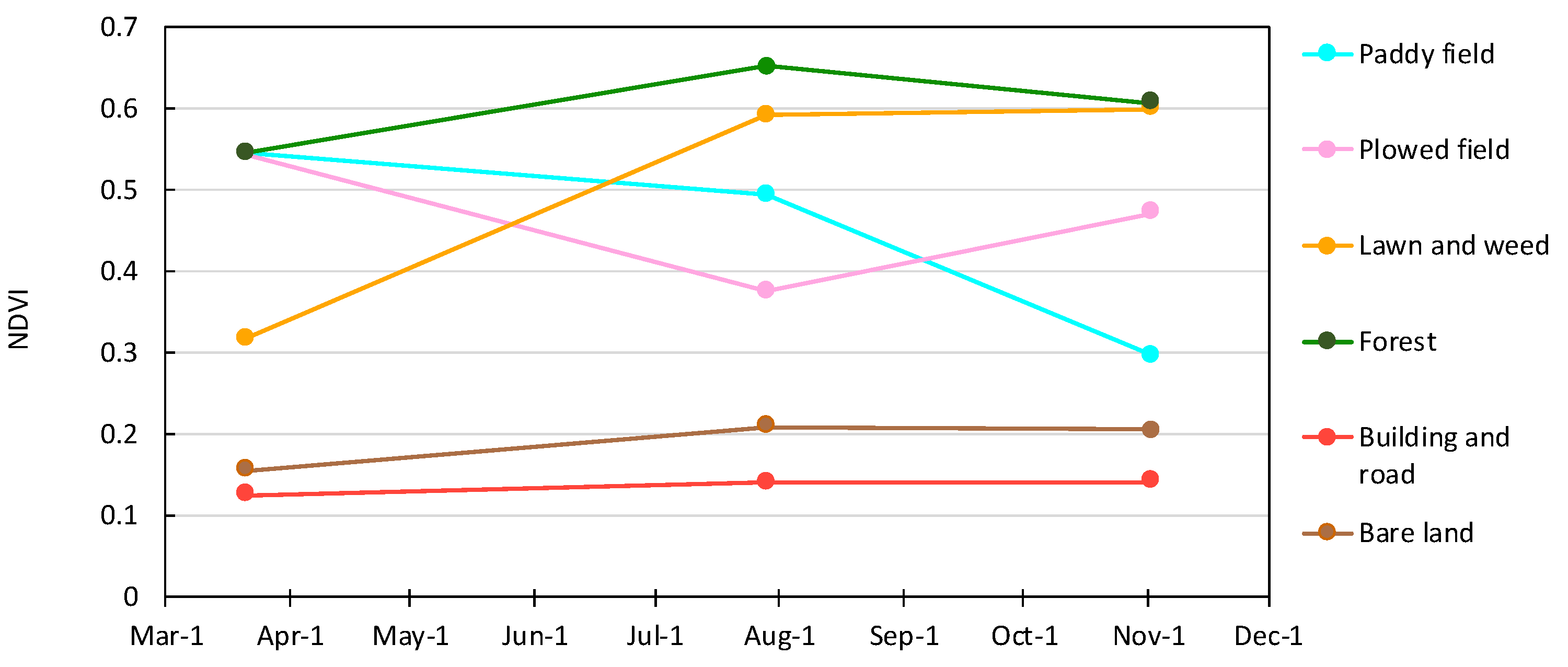
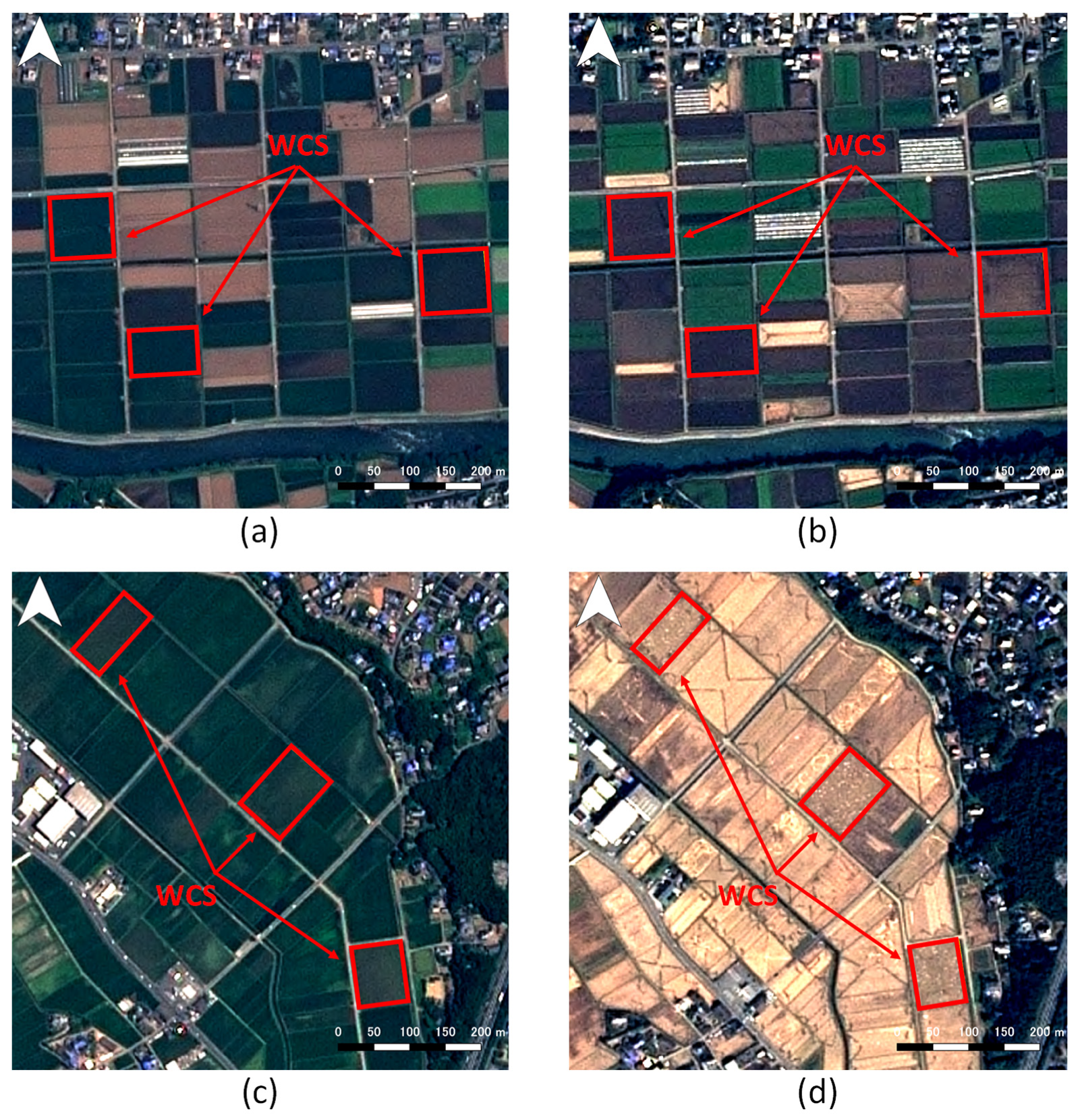




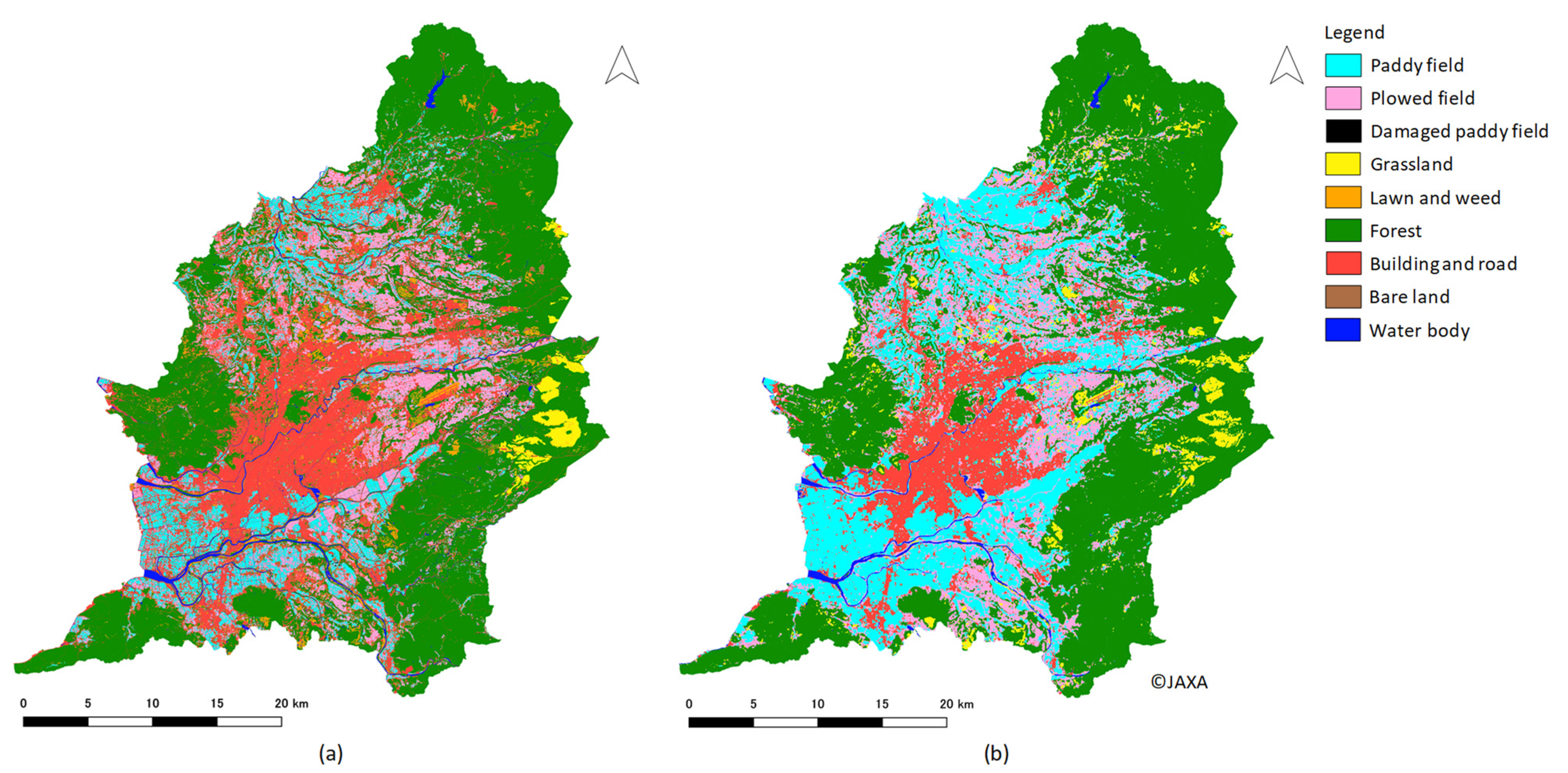
| Land Cover Type | Infiltration Coefficient |
|---|---|
| Plowed field | 0.7 |
| Grassland and forest in mountainous area | 0.2 |
| Grassland and forest outside of mountainous area | 0.5 |
| Land Cover | Paddy Field | Plowed Field | Lawn and Weed | Forest | Building and Road | Bare Land | Total | Producer’s Accuracy (%) |
|---|---|---|---|---|---|---|---|---|
| Paddy field | 148 | 36 | 0 | 0 | 1 | 0 | 185 | 80.0 |
| Plowed field | 12 | 211 | 0 | 0 | 9 | 0 | 232 | 90.9 |
| Lawn and weed | 0 | 0 | 63 | 30 | 14 | 4 | 111 | 56.8 |
| Forest | 0 | 0 | 4 | 936 | 10 | 1 | 951 | 98.4 |
| Building and road | 1 | 7 | 7 | 16 | 394 | 0 | 425 | 92.7 |
| Bare land | 0 | 0 | 2 | 2 | 3 | 12 | 19 | 63.2 |
| Total | 161 | 254 | 76 | 984 | 431 | 17 | 1923 | |
| User’s accuracy (%) | 91.9 | 83.1 | 82.9 | 95.1 | 91.4 | 70.6 |
| Paddy Field | Plowed Field | Damaged Paddy Field | Grassland | Lawn and Weed | Forest | Building and Road | Bare Land | Water Body | Total | |
|---|---|---|---|---|---|---|---|---|---|---|
| km2 | 84.85 | 143.75 | 0.91 | 16.07 | 45.08 | 452.68 | 261.50 | 12.70 | 23.04 | 1040.58 |
| % | 8.15 | 13.81 | 0.09 | 1.54 | 4.33 | 43.50 | 25.13 | 1.22 | 2.21 | 99.98 |
| Paddy Field in Irrigation Season | Paddy Field in Non- Irrigation Season | Plowed Field | Damaged Paddy Field | Grassland | Lawn and Weed | Forest | Total | |
|---|---|---|---|---|---|---|---|---|
| Million m3 | 186.76 | 67.90 | 239.90 | 1.36 | 7.15 | 53.01 | 201.48 | 757.56 |
| % | 24.65 | 8.96 | 31.67 | 0.18 | 0.94 | 7.00 | 26.60 | 100.00 |
| Paddy Field in Irrigation Season | Paddy Field in Non- Irrigation Season | Plowed Field | Damaged Paddy Field | Grassland | Lawn and Weed | Forest | Total | |
|---|---|---|---|---|---|---|---|---|
| Million m3 | 189.69 | 68.46 | 239.90 | 0.00 | 7.16 | 53.01 | 201.64 | 759.86 |
| % | 24.96 | 9.01 | 31.57 | 0.00 | 0.94 | 6.98 | 26.54 | 100.00 |
Publisher’s Note: MDPI stays neutral with regard to jurisdictional claims in published maps and institutional affiliations. |
© 2022 by the authors. Licensee MDPI, Basel, Switzerland. This article is an open access article distributed under the terms and conditions of the Creative Commons Attribution (CC BY) license (https://creativecommons.org/licenses/by/4.0/).
Share and Cite
Amano, H.; Iwasaki, Y. Estimation of Groundwater Recharge in Kumamoto Area, Japan in 2016 by Mapping Land Cover Using GIS Data and SPOT 6/7 Satellite Images. Sustainability 2022, 14, 545. https://doi.org/10.3390/su14010545
Amano H, Iwasaki Y. Estimation of Groundwater Recharge in Kumamoto Area, Japan in 2016 by Mapping Land Cover Using GIS Data and SPOT 6/7 Satellite Images. Sustainability. 2022; 14(1):545. https://doi.org/10.3390/su14010545
Chicago/Turabian StyleAmano, Hiroki, and Yoichiro Iwasaki. 2022. "Estimation of Groundwater Recharge in Kumamoto Area, Japan in 2016 by Mapping Land Cover Using GIS Data and SPOT 6/7 Satellite Images" Sustainability 14, no. 1: 545. https://doi.org/10.3390/su14010545
APA StyleAmano, H., & Iwasaki, Y. (2022). Estimation of Groundwater Recharge in Kumamoto Area, Japan in 2016 by Mapping Land Cover Using GIS Data and SPOT 6/7 Satellite Images. Sustainability, 14(1), 545. https://doi.org/10.3390/su14010545





